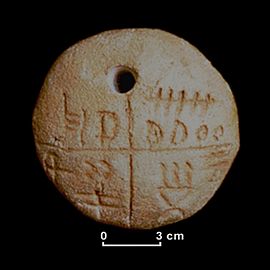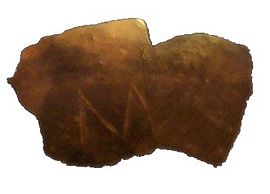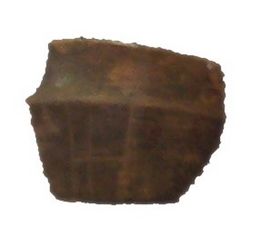Vinča symbols facts for kids
The Vinča symbols, sometimes known as the Danube script, Vinča signs, Vinča script, Vinča–Turdaș script, Old European script, etc., are a set of untranslated symbols found on Neolithic era artifacts from the Vinča culture and related "Old European" cultures of Central Europe and Southeastern Europe. Whether this is one of the earliest writing systems or simply symbols of some sort is disputed. They have sometimes been described as an example of "pre-writing" or "proto-writing". The symbols went out of use around 3500 BC.
Discovery
In 1875, archaeological excavations directed by the Hungarian archaeologist Baroness Zsófia Torma (1840–1899) at Tordos (present Turdaș, Romania) unearthed marble and fragments of pottery inscribed with previously unknown symbols. At the site, on the Mureş river, a feeder into a tributary of the Danube, female figurines, pots, and artifacts made of stone were also found. In 1908, a similar cache was found during excavations directed by Serbian archaeologist Miloje Vasić (1869–1956) in Vinča, a suburb of Belgrade (Serbia), some 245 km from Turdaș. Later, more such fragments were found in Banjica, another part of Belgrade. Since 1875, over 150 Vinča sites have been identified in Serbia alone, but many, including Vinča itself, have not been fully excavated. Thus, the culture of the whole area is called the Vinča culture, and the symbols are often called the Vinča–Turdaș script.
The discovery of the Tărtăria tablets in Romania by a team directed by Nicolae Vlassa in 1961 revived the debate. Vlassa believed the inscriptions to be pictograms. Other items found at the site of the discovery were subsequently radiocarbon-dated to before 4,000 BC, 1,300 years earlier than the date Vlassa expected and pre-dating the writing systems of the Sumerians and Minoans. However, the circumstances of their discovery and authenticity of the tablets themselves is disputed.
The Gradeshnitsa tablets are clay artefacts with incised marks. They were unearthed in 1969 near the village of Gradeshnitsa in the Vratsa Province of north-western Bulgaria. The tablets are dated to the 4th millennium BC and are currently preserved in the History Museum of Vratsa.
Corpus
Although a large number of symbols are known, most artifacts contain so few symbols that they are very unlikely to represent a complete text. Possibly the only exception is the Sitovo inscription in Bulgaria, the dating of which is disputed; regardless, even that inscription has only around 50 symbols.
Most of the inscriptions are on pottery, with the remainder appearing on ceramic spindle whorls, figurines, and a small collection of other objects. The symbols themselves consist of a variety of abstract and representative pictograms, including zoomorphic (animal-like) representations, combs or brush patterns and abstract symbols such as swastikas, crosses and chevrons. Over 85% of the inscriptions consist of a single symbol. Other objects include groups of symbols, of which some are arranged in no particularly obvious pattern, with the result that neither the order nor the direction of the signs in these groups is readily determinable. The usage of symbols varies significantly between objects; symbols that appear by themselves tend almost exclusively to appear on pots, while symbols that are grouped with other symbols tend to appear on whorls. Quantitative linguistic analysis leads to the conclusion that 59% of the signs share the properties of pottery marks, 11.5% are part of asymmetric ornaments typical for whorls of the Vinca culture, and 29.5% may represent some sort of symbolic (semasiographic) notation.
A database of Vinca inscriptions, DatDas, has been developed by Marco Merlini:
DatDas organizes a catalogue of 5,421 actual signs. These are recorded from a corpus of 1,178 inscriptions composed of two or more signs and 971 inscribed artifacts (some finds have two or more inscriptions).
Dating
These findings are important because the bulk of the Vinča symbols were created between 4500 and 4000 BC, with the symbols on the Tărtăria clay tablets possibly dating back to around 5300 BC (controversially dated by association). This means that the Vinča finds predate the proto-Sumerian pictographic script from Uruk (modern Iraq), which is usually considered to be the oldest known writing system, by more than a thousand years. Analyses of the symbols showed that they have little similarity with Near Eastern writing, resulting in the opinion that these symbols and the Sumerian script probably arose independently.
See also
 In Spanish: Escritura Vinča para niños
In Spanish: Escritura Vinča para niños
- Banpo symbols, located not far from site of Jiahu discovery; also claimed as proto-writing.
- Dispilio Tablet
- Gradeshnitsa tablets
- Jiahu symbols, an even older example sometimes claimed as proto-writing.
- Kamyana Mohyla, Ukraine, petroglyphs from caves used as early as 20th century BC.
- List of inscriptions in Serbia
- Undeciphered writing systems
- Old European cultures
- Prehistoric Romania
- Prehistoric Serbia
- Sitovo inscription






